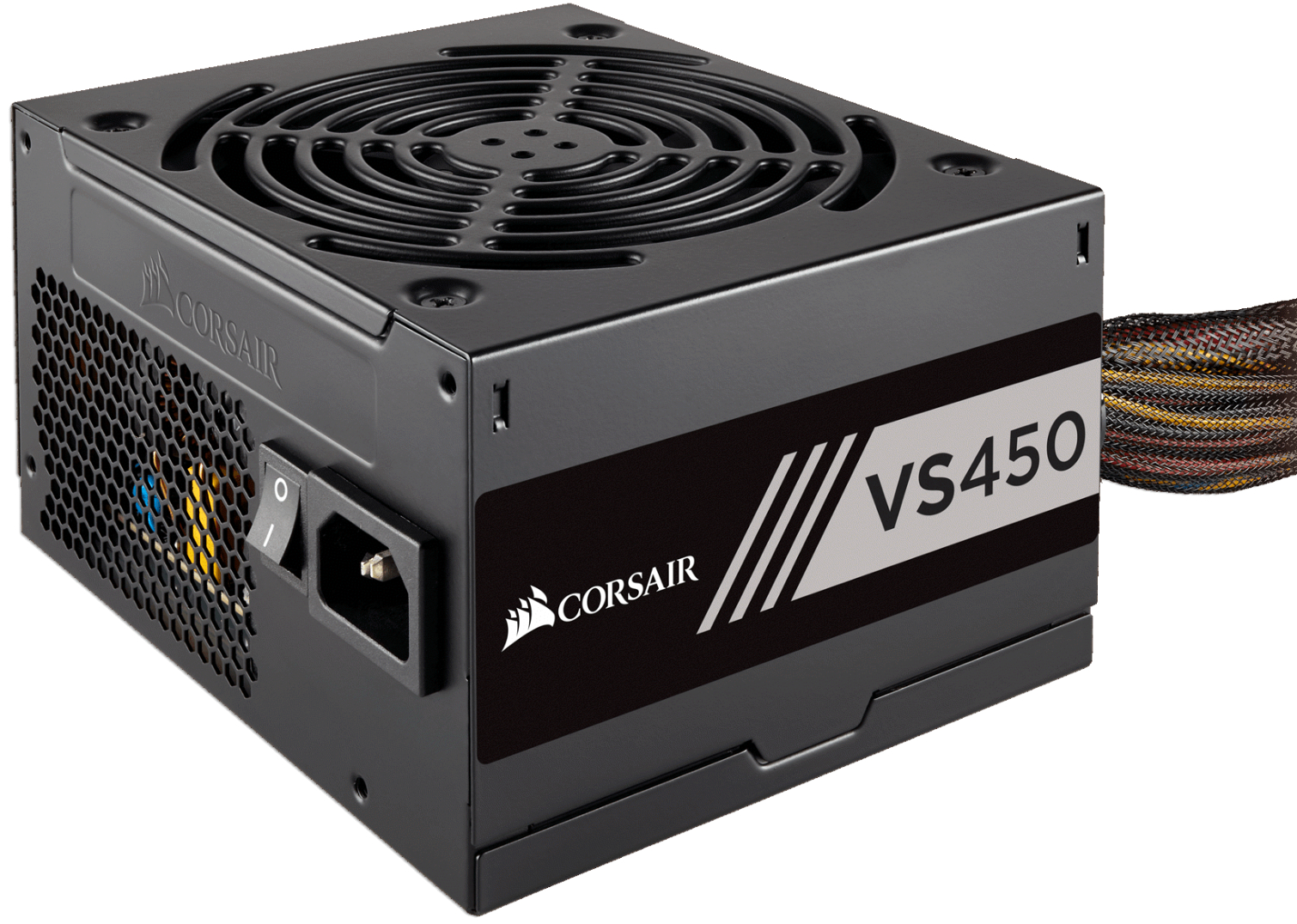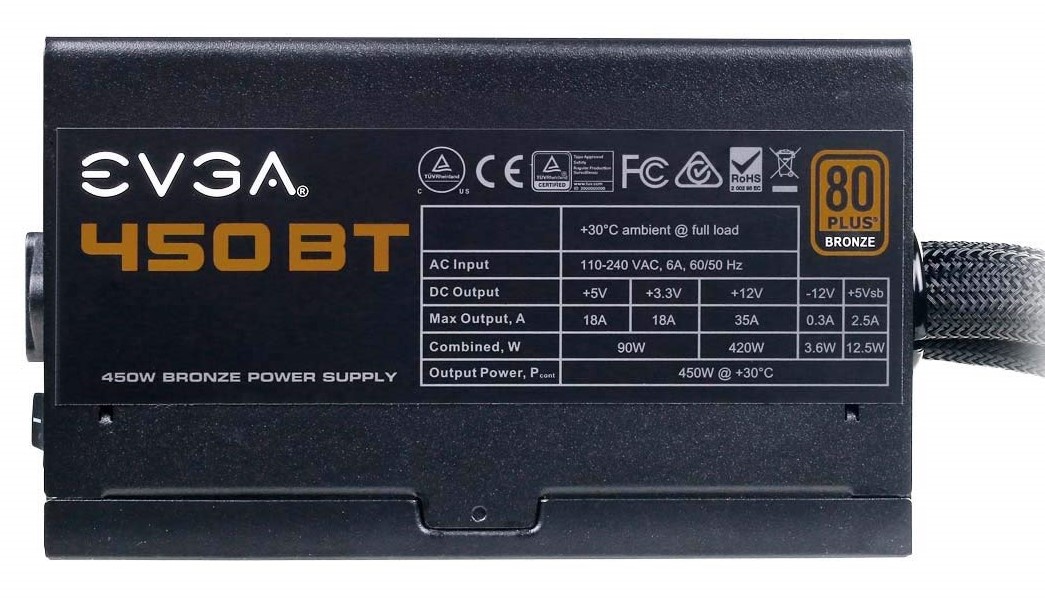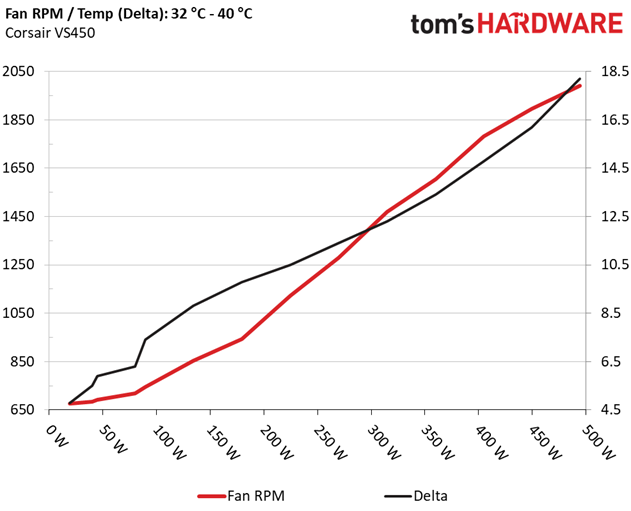Corsair VS450 Power Supply Review: Affordable and Reliable
Why you can trust Tom's Hardware
Load Regulation, Hold-Up Time, Inrush Current, Efficiency and Noise
To learn more about our PSU tests and methodology, please check out How We Test Power Supply Units.
Primary Rails and 5VSB Load Regulation
The following charts show the main rails' voltage values recorded between a range of 40W up to the PSU's maximum specified load, along with the deviation (in percent). Tight regulation is an important consideration every time we review a power supply, because it facilitates constant voltage levels despite varying loads. Tight load regulation also, among other factors, improves the system’s stability, especially under overclocked conditions and, at the same time, it applies less stress to the DC-DC converters that many system components utilize.
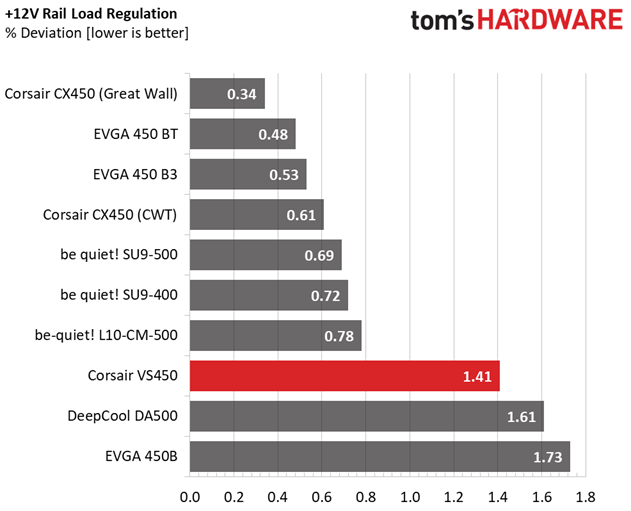

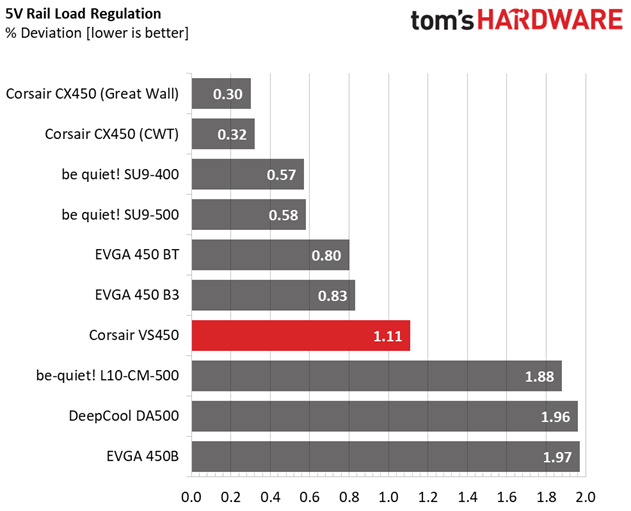
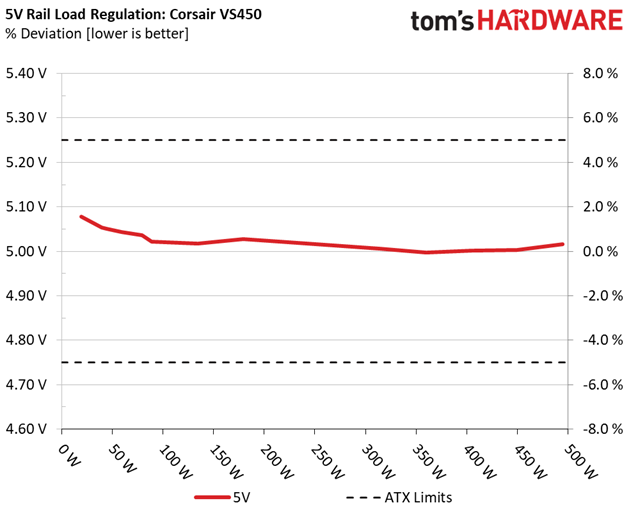
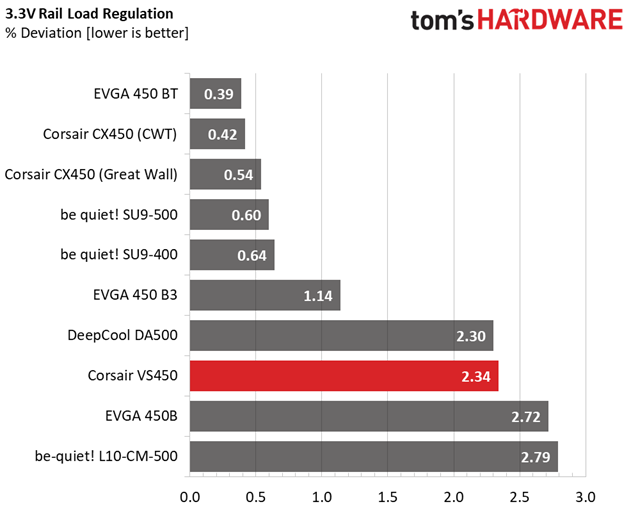
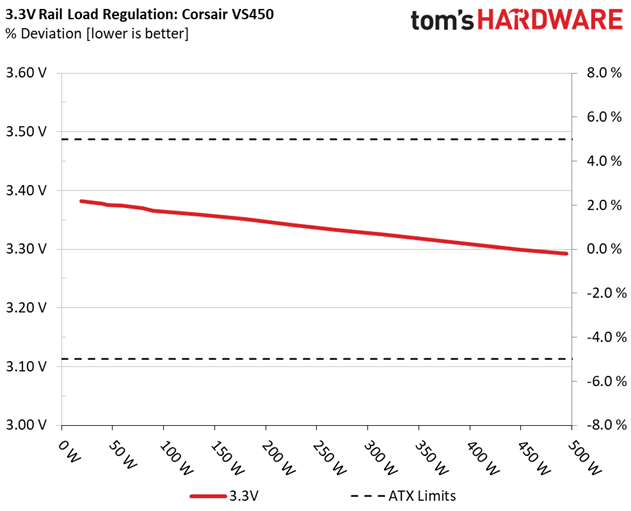
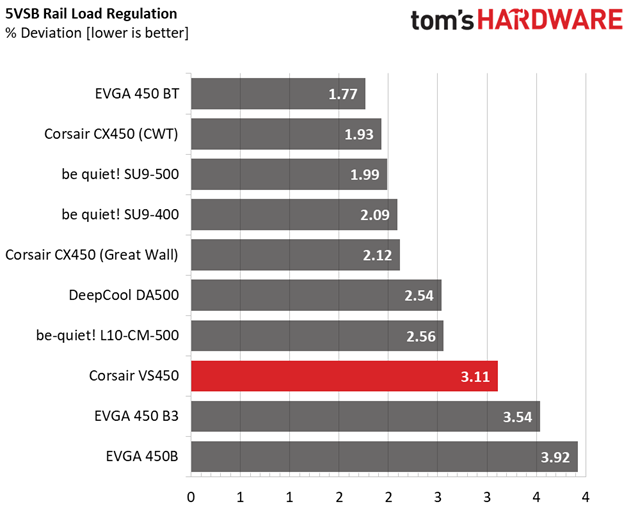
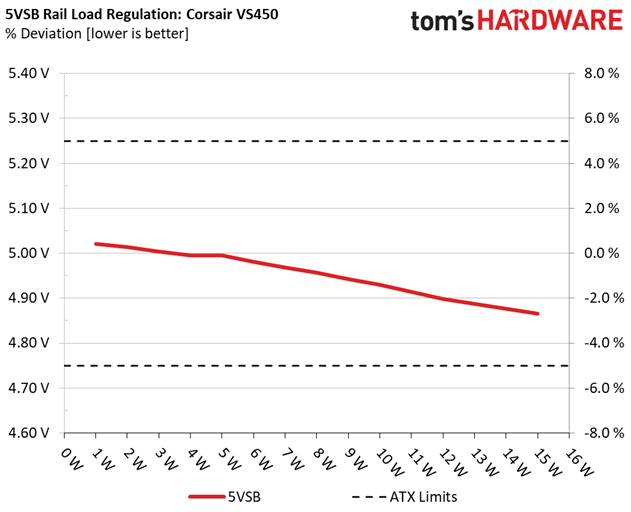
The load regulation at +12V doesn't look so good, compared to more expensive products. Nonetheless, it is within 2% so it is acceptable. The 5V rail is close to 1.1% and the 3.3V rail stays within 3%, with only the 5VSB going over 3%.
Hold-Up Time
Put simply, hold-up time is the amount of time that the system can continue to run without shutting down or rebooting during a power interruption.
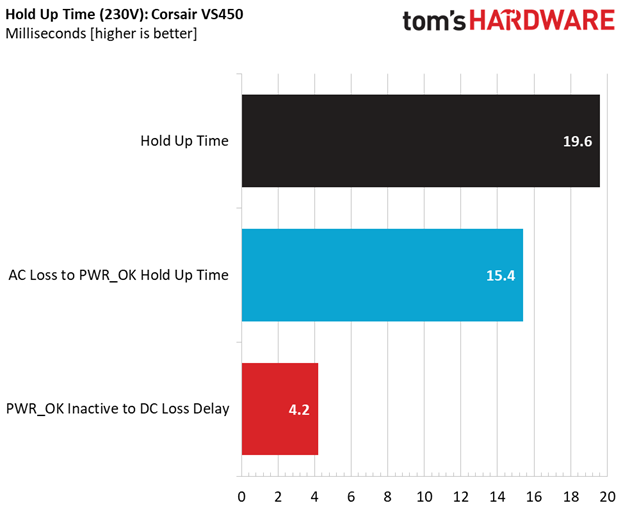

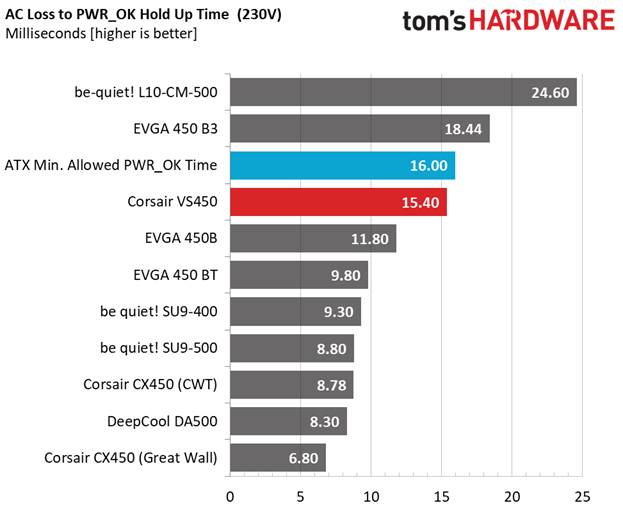

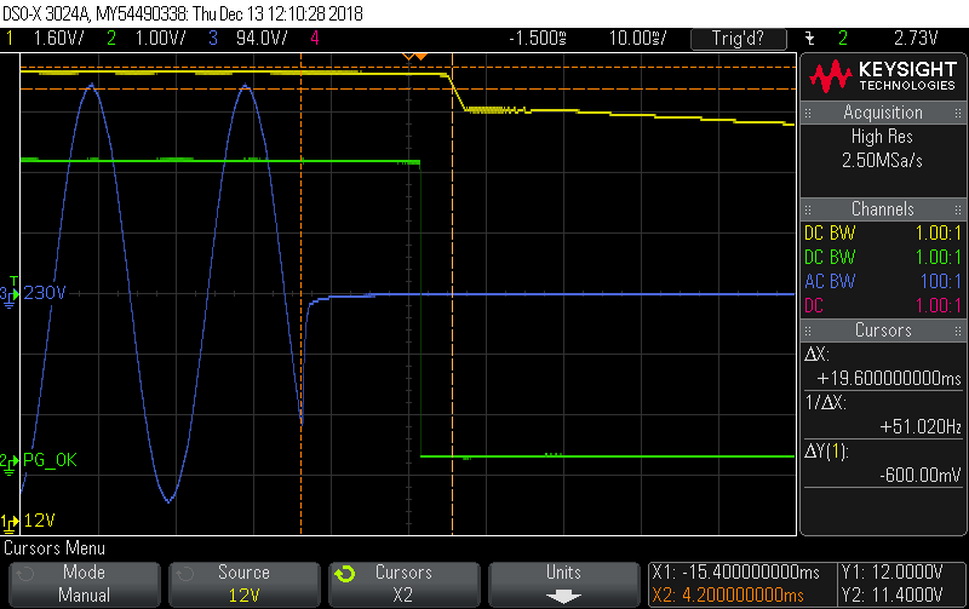
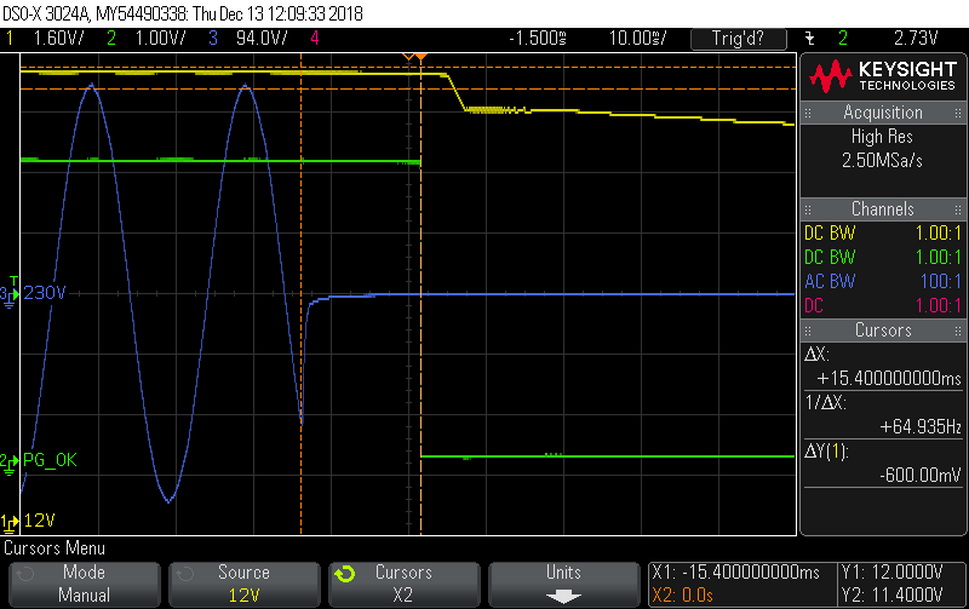
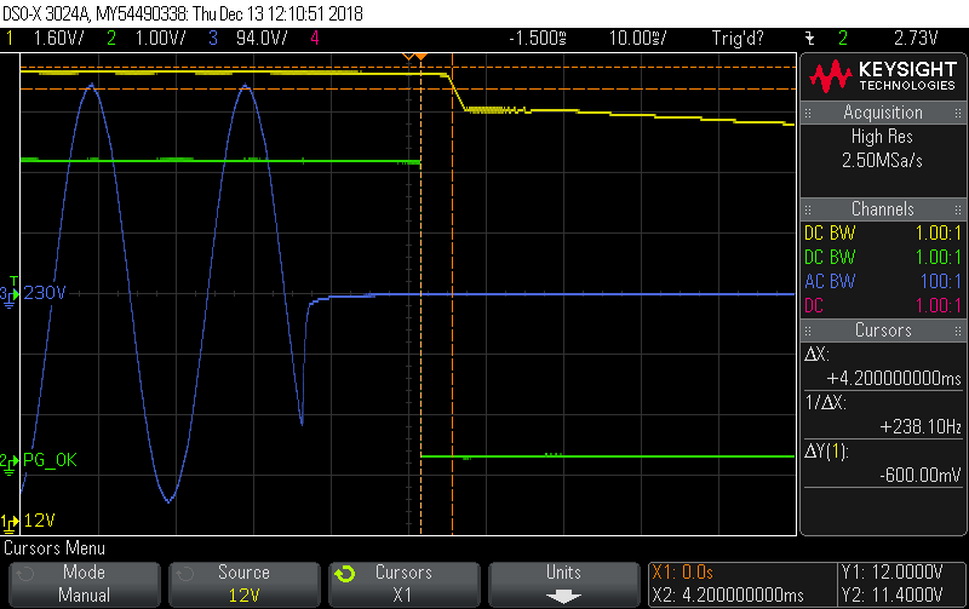
We didn't expect to measure such a long hold-up time in a budget PSU like the VS450. Kudos to Corsair for this! The power ok signal is also accurate.
Inrush Current
Inrush current, or switch-on surge, refers to the maximum, instantaneous input current drawn by an electrical device when it is first turned on. A large enough inrush current can cause circuit breakers and fuses to trip. It can also damage switches, relays, and bridge rectifiers. As a result, the lower the inrush current of a PSU right as it is turned on, the better.


The inrush currents are at normal levels, with both voltage inputs.
Get Tom's Hardware's best news and in-depth reviews, straight to your inbox.
10-110% Load Tests
These tests reveal the Corsair VS450’s load regulation and efficiency levels under high ambient temperatures. They also show how the fan speed profile behaves under increased operating temperatures.
| Test # | 12V | 5V | 3.3V | 5VSB | DC/AC (Watts) | Efficiency | Fan Speed (RPM) | PSU Noise (dB[A]) | Temps (In/Out) | PF/AC Volts |
|---|---|---|---|---|---|---|---|---|---|---|
| 1 | 1.902A | 1.992A | 1.954A | 1.001A | 44.725 | 76.102% | 715 | 16.8 | 35.35°C | 0.970 |
| 12.163V | 5.018V | 3.375V | 4.995V | 58.770 | 42.16°C | 115.04V | ||||
| 2 | 4.809A | 2.992A | 2.939A | 1.205A | 89.220 | 82.473% | 744 | 17.7 | 35.91°C | 0.987 |
| 12.131V | 5.009V | 3.366V | 4.981V | 108.181 | 43.27°C | 115.04V | ||||
| 3 | 8.127A | 3.488A | 3.422A | 1.409A | 134.362 | 84.351% | 852 | 20.8 | 36.06°C | 0.992 |
| 12.104V | 5.017V | 3.359V | 4.968V | 159.290 | 44.86°C | 115.04V | ||||
| 4 | 11.448A | 3.979A | 3.937A | 1.614A | 179.590 | 84.938% | 943 | 23.5 | 36.71°C | 0.988 |
| 12.089V | 5.027V | 3.351V | 4.957V | 211.437 | 46.49°C | 115.04V | ||||
| 5 | 14.435A | 4.979A | 4.936A | 1.821A | 224.896 | 84.740% | 1124 | 28.2 | 37.16°C | 0.989 |
| 12.082V | 5.020V | 3.342V | 4.943V | 265.394 | 47.69°C | 115.04V | ||||
| 6 | 17.364A | 5.987A | 5.939A | 2.029A | 269.426 | 84.257% | 1280 | 32.1 | 37.51°C | 0.991 |
| 12.072V | 5.013V | 3.333V | 4.929V | 319.766 | 48.91°C | 115.04V | ||||
| 7 | 20.368A | 6.993A | 6.947A | 2.239A | 314.725 | 83.547% | 1470 | 35.0 | 38.80°C | 0.993 |
| 12.059V | 5.006V | 3.325V | 4.914V | 376.703 | 51.11°C | 115.04V | ||||
| 8 | 23.377A | 8.006A | 7.962A | 2.451A | 360.035 | 82.741% | 1605 | 37.5 | 38.90°C | 0.994 |
| 12.047V | 4.997V | 3.316V | 4.898V | 435.136 | 52.34°C | 115.04V | ||||
| 9 | 26.835A | 8.499A | 8.464A | 2.455A | 404.937 | 81.834% | 1782 | 40.2 | 39.38°C | 0.994 |
| 12.015V | 5.002V | 3.308V | 4.889V | 494.829 | 54.21°C | 115.04V | ||||
| 10 | 30.025A | 8.996A | 9.002A | 3.084A | 449.767 | 80.695% | 1897 | 42.6 | 39.74°C | 0.995 |
| 11.992V | 5.003V | 3.299V | 4.865V | 557.369 | 55.95°C | 115.03V | ||||
| 11 | 33.885A | 8.972A | 9.022A | 3.089A | 494.565 | 79.514% | 1990 | 42.8 | 40.14°C | 0.996 |
| 11.948V | 5.016V | 3.292V | 4.857V | 621.987 | 58.30°C | 115.03V | ||||
| CL1 | 0.130A | 13.000A | 13.000A | 0.000A | 103.069 | 75.799% | 1375 | 33.6 | 37.76°C | 0.987 |
| 12.644V | 4.461V | 3.341V | 4.969V | 135.976 | 48.08°C | 115.05V | ||||
| CL2 | 35.998A | 1.000A | 1.000A | 1.000A | 435.565 | 81.387% | 1707 | 39.5 | 39.45°C | 0.995 |
| 11.723V | 5.298V | 3.322V | 4.940V | 535.177 | 55.57°C | 115.04V |
The PSU can handle increased temperatures for short periods at least. The fan has to work at high speeds though, to cope with the increased heat levels.
Only during the 10%, 110% and CL1 load tests, the PSU's efficiency drops below 80%. This looks good for an 80 PLUS white and Cybenetics ETA-S certified product. Moreover, because of the group regulated scheme on the secondary side, the performance in the CL1 and CL2 tests is bad. As you can see on the table above, the +12V and 5V rails have a hard time keeping their voltages within the specified, by the ATX spec, range.
20-80W Load Tests
In the following tests, we measure the Corsair VS450's efficiency at loads significantly lower than 10% of its maximum capacity (the lowest load the 80 PLUS standard measures). This is important for representing when a PC is idle with power-saving features turned on.
| Test # | 12V | 5V | 3.3V | 5VSB | DC/AC (Watts) | Efficiency | Fan Speed (RPM) | PSU Noise (dB[A]) | PF/AC Volts |
|---|---|---|---|---|---|---|---|---|---|
| 1 | 1.172A | 0.489A | 0.472A | 0.199A | 19.347 | 66.952% | 677 | 15.5 | 0.922 |
| 12.175V | 5.078V | 3.382V | 5.021V | 28.897 | 115.04V | ||||
| 2 | 2.431A | 0.988A | 0.972A | 0.399A | 39.765 | 76.585% | 683 | 15.9 | 0.967 |
| 12.130V | 5.053V | 3.378V | 5.013V | 51.923 | 115.04V | ||||
| 3 | 3.623A | 1.486A | 1.450A | 0.600A | 59.306 | 80.235% | 693 | 16.2 | 0.977 |
| 12.122V | 5.043V | 3.374V | 5.004V | 73.915 | 115.04V | ||||
| 4 | 4.883A | 1.985A | 1.955A | 0.801A | 79.744 | 82.189% | 719 | 16.8 | 0.982 |
| 12.115V | 5.036V | 3.370V | 4.995V | 97.025 | 115.04V |
Under light loads, the registered efficiency levels are low.
Efficiency
Next, we plotted a chart showing the Corsair VS450’s efficiency at low loads, and loads from 10 to 110% of its maximum-rated capacity. The higher a PSU’s efficiency, the less energy goes wasted leading to a reduced carbon footprint, besides lower electricity bills.
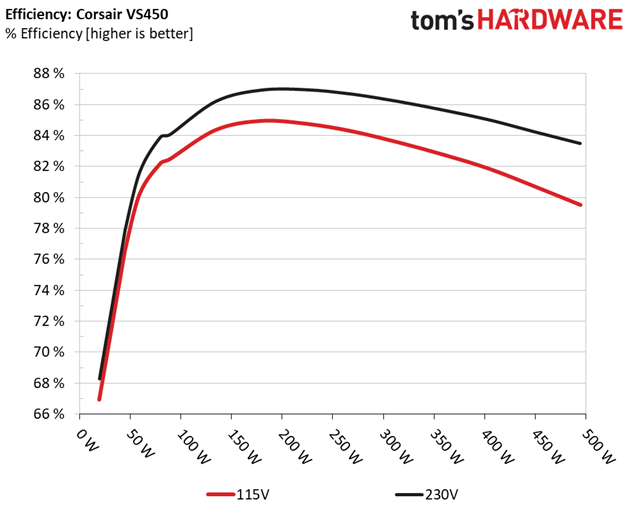
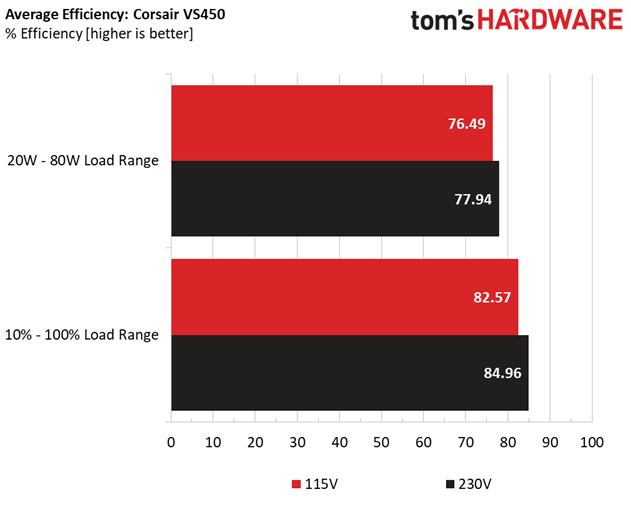
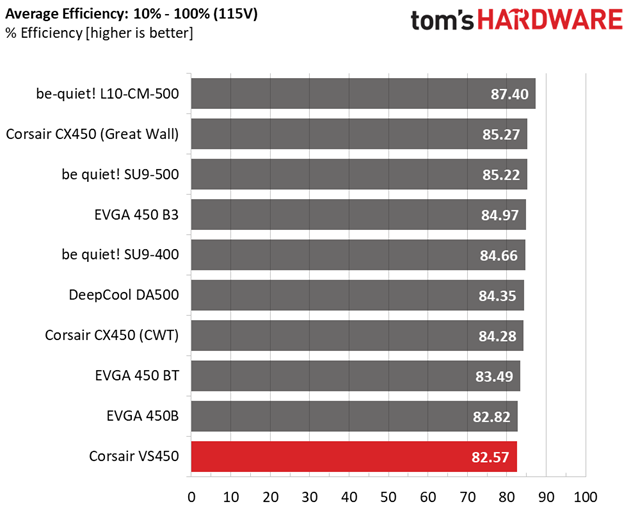
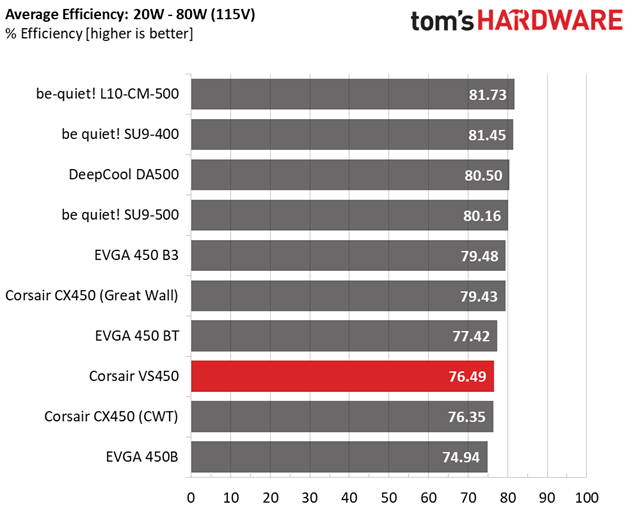
Given its low efficiency certifications, we didn't have high expectations.
5VSB Efficiency
| Test # | 5VSB | DC/AC (Watts) | Efficiency | PF/AC Volts |
|---|---|---|---|---|
| 1 | 0.100A | 0.503 | 77.984% | 0.093 |
| 5.029V | 0.645 | 115.03V | ||
| 2 | 0.250A | 1.256 | 80.256% | 0.193 |
| 5.026V | 1.565 | 115.03V | ||
| 3 | 0.550A | 2.761 | 80.897% | 0.299 |
| 5.020V | 3.413 | 115.03V | ||
| 4 | 1.000A | 5.010 | 81.016% | 0.366 |
| 5.010V | 6.184 | 115.03V | ||
| 5 | 1.500A | 7.499 | 80.634% | 0.402 |
| 5.000V | 9.300 | 115.03V | ||
| 6 | 3.000A | 14.900 | 77.030% | 0.450 |
| 4.967V | 19.343 | 115.03V |

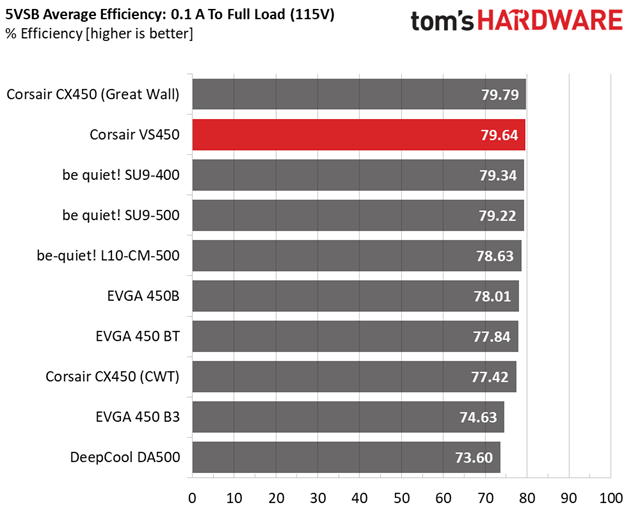
The 5VSB rail is highly efficient. This is a nice surprise!
Power Consumption In Idle and Standby
| Mode | 12V | 5V | 3.3V | 5VSB | Watts | PF/AC Volts |
|---|---|---|---|---|---|---|
| Idle | 12.181V | 5.090V | 3.385V | 5.031V | 4.930 | 0.486 |
| 115.0V | ||||||
| Standby | 0.045 | 0.007 | ||||
| 115.0V |
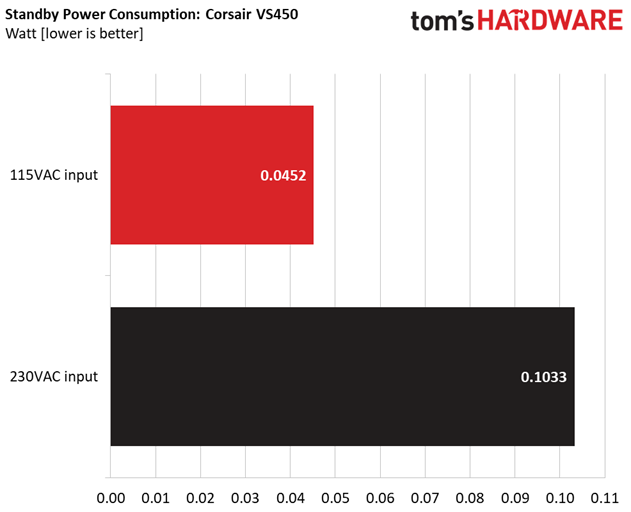
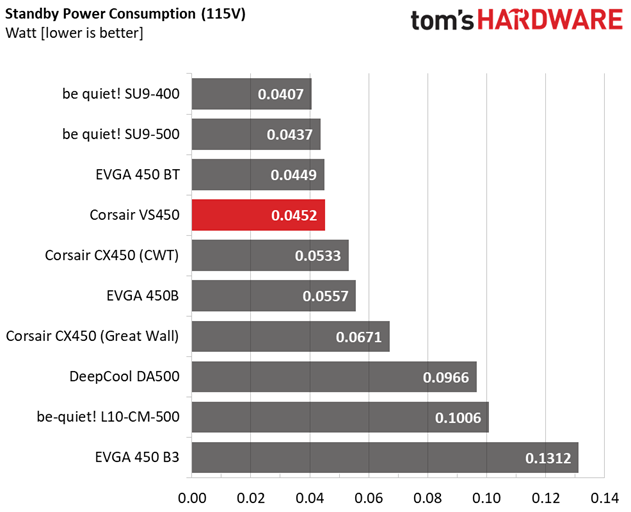
Fan RPM, Delta Temperature and Output Noise
All results are obtained between an ambient temperature of 32 to 40 degrees Celsius (89.6 to 104 degrees Fahrenheit).
The fan profile gets aggressive under high operating temperatures, which is normal given this product's low temperature rating (30°C).
The following results were obtained at 30 to 32 degrees Celsius (86 to 89.6 degrees Fahrenheit) ambient temperature.
The fan profile is much better under normal operating temperatures. With higher than 300W loads the output noise is within the 35-40 dB(A) (comparative noise example: library) range.
MORE: Best Power Supplies
MORE: How We Test Power Supplies
MORE: All Power Supply Content
Current page: Load Regulation, Hold-Up Time, Inrush Current, Efficiency and Noise
Prev Page Specifications and Part Analysis Next Page Protection Features, DC Power Sequencing, Cross-Load Tests and Infrared Images
Aris Mpitziopoulos is a contributing editor at Tom's Hardware, covering PSUs.
